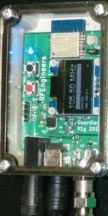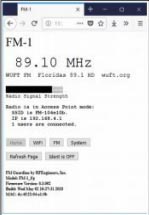RF Engineers’ FM Guardian

[September 2018] There many reasons stations need to have dedicated receivers to handle various applications, including station monitoring, EAS, translator input, and other such things. Alan Alsobrook reports on a new option.
In the old days, many stations used car radios in the rack for monitoring purposes.
Later, radios from Dayton Industries were favored. Neither is the answer today. Since Dayton shut down production a few years ago, I have found few good sources for such receivers.
Now with the introduction of the FM Guardian by RF Engineers, of Gainesville FL. that seems to be changing.
FM Guardian
I was sent one of the first run units and it works quite well.
Although I know there have been a few improvements with the firmware since this unit came off the line, even without the new firmware my sample unit preformed quite well.
 The first thing I noticed was the small size. It is a whole 3.25 x 2.25 x 1.25 inches. (It weighs in at just 2.9 ounces.)
The first thing I noticed was the small size. It is a whole 3.25 x 2.25 x 1.25 inches. (It weighs in at just 2.9 ounces.)
Of course, to install it you will need some extra room off of the end for connections, coax, pow-er, and audio.
If you look closely, you will see there are no dip switches. A read of the quick-start sheet indicated that this unit is controlled via Wi-Fi – and yes, it can reside on your network for easy control at your desk.
Setup
It only took a few minutes from opening the box to having the FM Guardian fully operational.
I made the initial connection via my iPhone. (There is an android app available as well as an 2 iPhone app currently under development, but I did not need an app with the onboard Wi-Fi and Web server.) I had full control in seconds.
What really surprised me is that as soon as I connected to the FM Guardians Wi-Fi it immediately opened the web server page for direct control of the unit without my even having to open the browser. I had never seen that happen before, but it sure was nice.
I did not have to type in an IP address or anything else. All I had to do was type in the frequency I wanted, and there it was: nice and clean – and in stereo. Once the configuration is saved, the receiver comes right back on channel after a power outage.

FM Guardian Home Screen
One of the neat features I noticed is that the display auto shuts off after a user determined period, but if you turn the lights on or tap the box it will come back on.
At first I thought there was a bad connection, until I found out that it has a vibration sensor and photo cell in the FM Guardian to activate the display.
A Closer Look Inside
Getting down to the nuts and bolts of the FM Guardian:
- The RF input is via a female F connector and it is very sensitive – perhaps a bit too sensitive, but nothing an inline 10 dB attenuator left over from the XDS installation kit would not fix. (yes, those ones that have FAMP-10 are attenuators not amplifiers.)
- Power is provided by a 9V at 1A switching wall wart. I measured the actual power draw at just under 120 mA or about 1.1 Watts.
- The stereo audio is provided by a 1/8” TRS jack. The audio output is adjustable from around -30 to -10 dB. The default level of “3” is around -20 dB.
It Is Sensitive
In general, sensitivity is not an issue. I noted that it would receive stronger stations even with the antenna disconnected.
During testing with 70 kHz deviation of a 1 kHz tone, it took about 3 uV of signal to get THD of the received signal down below 1%. By 5 uV the THD was 0.41% and 10 uV had it down to 0.26% THD.
Too Sensitive?
On the other hand, the receiver’s signal strength meter hit full scale at 7 uV, as noted earlier, perhaps a bit too sensitive.
This might be the reason for less than optimal selectivity on weak signals in high signal areas. I was testing it in close proximity of 3 FM and 2 translator sites, and it had difficulty receiving a distant weak translator until I added 10 dB of attenuation to the antenna line.
A chat with the folks at RF Engineers and I was told a firmware upgrade was already in preparation that will solve this issue.
An Area to Improve
So it seems likely the FM Guardian experienced some de-sensing caused by the nearby transmitters.
There was also an issue when receiving some weak signals: there was a “put-put” in the audio.
After some investigation, I determined that issue was caused by reflecting surfaces in the area and varied with movement. Upon further checking, I noted that the noise went away once the Wi-Fi was turned off.
Given the information I have, I think the Wi-Fi transmitter is getting back into the receiver somehow and causing the noise. However, even as is, I do not see that as a big problem.
Since I was able eliminate the noise by turning off the Wi-Fi, if the shielding of the receiver is improved, I think it will help or resolve the WiFi noise issue, as well as keep other potential interference out of the receiver.
Verdict
Overall I was happy with the performance of the FM Guardian and think it will fill a need for stations.
Checking around with Bob Groome of RF Specialties, I learned the FM Guardian has a street price of around $250.
This will certainly solve receiver issues for a number of people.
– – –
More information about the FM Guardian is located here.
– – –
Alan Alsobrook is a regular contributor to The BDR. He is contract engineer based in St. Augustine, FL Contact him at: aalso@bellsouth.net
